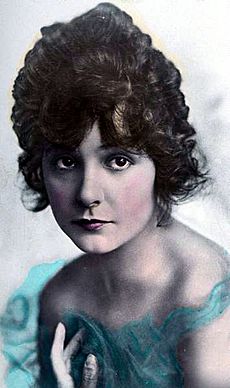Roaring Twenties facts for kids
| 1920–1929 | |

Josephine Baker performing the Charleston
|
|
| Preceded by | World War I - Spanish flu |
|---|---|
| Followed by | Great Depression - Wall Street Crash of 1929 |
The Roaring Twenties was a special time in the 1920s. It was a period of big changes in music, fashion, and culture, especially in Western countries like the United States and Europe. People often called it the "Jazz Age" because jazz music became super popular.
This decade was a time of economic growth and new ideas. Cities like Berlin, Chicago, London, New York City, and Paris were buzzing with excitement. In France, they called it the années folles, meaning "crazy years." After World War I and the Spanish flu, people wanted to return to normal life. They embraced new technologies like cars, movies, and radio. This brought a feeling of "modernity" to many people.
The 1920s saw huge developments in cars, phones, movies, radio, and electric appliances. These things changed how millions of people lived. Countries grew fast in industry and economy. People wanted to buy more new things. The media, with new mass-market advertising, focused on famous people. Sports heroes and movie stars became very popular. In many countries, women gained the right to vote.
By the middle of the decade, many places were doing well. But this exciting time came to a sudden end. The Wall Street Crash of 1929 caused a huge economic downturn. This led to the Great Depression, which brought tough times around the world.
Economy and New Inventions
The 1920s was a time of great economic growth. Countries were recovering from the war. People started buying many new things like cars and electric appliances. The United States economy grew very fast. It became the richest country in the world. Its factories made goods in huge amounts. People also started to buy more and more. European economies took a bit longer to recover, but they also started to do well around 1924.
After the war, there was a short economic slowdown. But soon, economies in the U.S. and Canada bounced back. Soldiers came home and found jobs. Factories that made war supplies started making things for people to buy.
New Products and Technologies
Mass production made new technologies affordable for many families. Industries like cars, movies, radio, and chemicals grew quickly in the 1920s.
Cars Become Popular
Before World War I, cars were mostly for rich people. But in the 1920s, mass-produced cars became common. By 1927, the Ford Motor Company had sold 15 million Ford Model T cars. They then introduced a new model, the Ford Model A.
By 1929, nearly 27 million cars were registered in the United States. Cars changed many other industries. They boosted steel production, highway building, and the creation of motels and gas stations. Cars gave people more freedom to travel and live outside cities.
Radio Becomes a Hit
Radio became the first way to broadcast to many people at once. Radios were expensive, but they offered amazing new entertainment. Radio advertising also became a big business. This led to the "mass culture" we know today. Radio shows were as varied as TV shows are now.
In 1925, new ways of recording sound made music records much better.
The Rise of Cinema
Movies became incredibly popular. They offered a new kind of entertainment that replaced old live shows like vaudeville. Going to the movies was cheap and easy. Huge, fancy movie theaters opened in cities. Many vaudeville performers started working in films because of better pay.
Sound Movies Arrive
At first, movies were silent. But in 1923, inventor Lee de Forest showed short films with sound. In 1926, the Vitaphone sound system was introduced. The film Don Juan (1926) was the first long movie to use Vitaphone for music and sound effects.
Then, in October 1927, The Jazz Singer became a huge success. It used sound in a new way. Most of the film had music and effects. But when the star, Al Jolson, sang, his voice was recorded live. He also had two scenes with spoken words. This showed the film industry that sound movies were worth investing in.
In 1928, major film studios started changing their theaters and production to handle sound films. Warner Bros. released Lights of New York (1928), the first full-length movie with all talking. The first animated sound film was Dinner Time (1928). A few months later, Walt Disney Animation Studios released Steamboat Willie (1928). This was the first successful animated sound film and introduced Mickey Mouse. Steamboat Willie was special because its sound was added after filming. It became the most popular cartoon of its time.
By 1929, silent films stopped being made. The last silent movie in the U.S. was released in April 1930.
Aviation Takes Off
The 1920s saw amazing achievements in flying. In 1927, Charles Lindbergh became famous. He was the first person to fly alone and without stopping across the Atlantic Ocean. He flew from New York to Paris in 33.5 hours in his plane, the Spirit of St. Louis. In Britain, Amy Johnson was the first woman to fly alone from Britain to Australia.
Early Television
Inventors worked on television in the 1920s. But TV shows didn't become common until much later, close to World War II. In 1928, John Logie Baird showed the world's first color TV transmission. He also showed 3D television that same year. Baird also sent a TV signal over 438 miles between London and Glasgow.
Medicine Advances
Scientists had been working on a medicine called penicillin for many years. In 1928, Scottish biologist Alexander Fleming discovered a substance that could kill many harmful bacteria. In 1929, he named it penicillin. At first, his discovery was not widely noticed. But in the 1930s, it became a very important antibiotic. In 1930, Cecil George Paine used penicillin to treat an eye infection in babies, achieving the first recorded cure.
New Infrastructure
The popularity of cars led to many new roads and bridges being built. These were paid for by taxes on gasoline. Farmers also used pickup trucks to move goods and people. New industries grew, like those making tires, glass, and fuel. Car dealerships and repair shops opened everywhere. Tourism also got a huge boost, with more hotels and restaurants.
Electricity spread greatly across the U.S. and Canada. Factories switched from coal to electricity. Many new power plants were built. In America, electricity production almost quadrupled.
Telephone lines were also installed across the continent. Many homes got indoor plumbing for the first time, thanks to modern sewer systems.
More Americans started living in cities than in rural areas by 1920. Cities like New York and Chicago competed to build the tallest skyscrapers. The Empire State Building in New York became the tallest. Many unmarried women found jobs in offices, using typewriters and telephones. In Canada, by the end of the decade, one in five workers were women.
Society and Culture
Women's Rights and Roles
Many countries gave women the right to vote between 1917 and 1921. This included the United States, Canada, Great Britain, and most major European countries. This change meant politicians paid more attention to issues important to women. These included peace, public health, and education.
In the U.S., the 19th Amendment in 1920 gave women the right to vote. This was a big step for political equality. A new generation of women emerged. They wanted both successful careers and families. This was different from older ideas that women had to choose one or the other. Women also became eager to compete and find personal happiness.
More women went to college. This challenged old ideas about what women could do. Advertising also started showing women in new ways. Car ads, for example, showed women enjoying new freedoms.
During World War I, women had worked in industries like chemicals and car manufacturing. These jobs were once thought to be only for men. After the war, many women lost these jobs. But the booming economy of the 1920s still offered more opportunities. Many young working-class girls could now seek jobs or training that would help them move up in society.
After gaining the right to vote, feminists focused on other goals. Groups like the National Woman's Party worked to remove laws that discriminated against women. They proposed the Equal Rights Amendment in 1923.
The Lost Generation
The "Lost Generation" was a group of young people who felt disappointed after World War I. They felt cynical about the world. This term often refers to American writers who lived in Paris. Famous members included Ernest Hemingway and F. Scott Fitzgerald. They wrote stories that showed their feelings about the materialism of the era.
In the United Kingdom, there were the "bright young things." These were young rich people who threw fancy parties. They were often talked about in London newspapers.
Social Criticism
As Americans became more interested in wealth and luxury, some writers started to criticize this. Sinclair Lewis was a very popular critic. His novel Main Street (1920) made fun of small-town life. Babbitt was about a businessman who tried to rebel against his boring life. Lewis also criticized religion in Elmer Gantry.
Other critics included Sherwood Anderson and Edith Wharton. They wrote about small towns and mocked the new fads of the era.
Art Deco Style

Art Deco was a popular style of design and architecture in the 1920s. It started in Europe and spread to North America. In the U.S., the Chrysler Building in New York City was a famous example. It was one of the tallest buildings at the time. Art Deco designs were clean and geometric. They often took inspiration from nature.
Cinema and Cartoons
At the start of the decade, films were silent and black and white. In 1922, The Toll of the Sea was the first full-length color film. As mentioned earlier, sound films became very popular by the end of the decade. Lights of New York (1928) was the first all-talking movie. On with the Show! (1929) was the first all-color, all-talking film.
Cartoon shorts were also very popular in movie theaters. Walt Disney became famous in the late 1920s. Mickey Mouse first appeared in Steamboat Willie on November 18, 1928. Mickey Mouse became a huge success and led to many more cartoons and the Mickey Mouse Club.
Many actors and actresses became big stars during this time. Some famous names include Charlie Chaplin, Rudolph Valentino, Clara Bow, Greta Garbo, and Al Jolson.
Harlem Renaissance
African-American culture thrived in the 1920s in a movement called the "Harlem Renaissance." In 1921, the Black Swan Corporation started making records. All-African American musicals also began in 1921. The Harlem Renaissance Basketball Club was founded in 1923. This team became known as the best in the world.
Important African American authors like Langston Hughes and Zora Neale Hurston gained national recognition during this time.
The Jazz Age
Jazz music became incredibly popular in the 1920s. It was especially loved by young people. Many historians say jazz was the "dominant influence on America's popular music."
Famous jazz musicians of the 1920s included Louis Armstrong, Duke Ellington, Sidney Bechet, and Jelly Roll Morton. Blues music also grew with singers like Bessie Smith. Later in the decade, early forms of country music started with artists like Jimmie Rodgers.
Dance Craze
Dance clubs became hugely popular in the 1920s. Dance music dominated all popular music. People loved to dance, and many songs were rearranged for dancing. Dance clubs held contests where people invented new moves. With sound movies, musicals became very popular. Gold Diggers of Broadway was a top-grossing musical film.
Harlem was a key place for new dance styles. Places like the Cotton Club and the Savoy Ballroom attracted people of all races. The most popular dances were the foxtrot, waltz, and American tango. But new, exciting dances also appeared. The Breakaway and Charleston were based on African American music. The Charleston became very popular after being in Broadway shows in 1922. The Lindy Hop also became a dominant social dance by 1927. These new dances influenced popular music greatly.
Fashion Changes

Paris set the fashion trends for Europe and North America. For women, fashion was all about being loose and comfortable. Women wore dresses every day. These dresses had a low waist and skirts that could be anywhere from the ankle to the knee. Hair was often cut short in a "bob" style, which gave a boyish look.
Young, rebellious women called 'flappers' became famous. They wore knee-length dresses that showed their legs and arms. They also started using cosmetics, which were not widely accepted before the 1920s. Magazines in Germany showed the "New Girl" or "flapper." She was fashionable, independent, and loved buying the latest styles.
For men in office jobs, business suits were common. They wore striped or plaid suits in dark colors in winter and lighter colors in summer. White shirts and neckties were essential.
Prohibition in the United States
In the early 1900s, many communities tried to stop gambling and drinking. In the U.S., this led to the Eighteenth Amendment and the Volstead Act. These laws made it illegal to make, import, or sell alcohol. The goal was to reduce crime and other problems. However, these laws were very unpopular. Many people broke the law, which led to a rise in organized crime.
Speakeasies Become Common
Speakeasies were illegal bars that sold alcohol. They became very popular in cities. They often paid off local police and officials to stay open. These speakeasies helped fund large-scale gangster operations. Even though federal agents raided these places, they continued to thrive because they made so much money. In big cities, speakeasies could be fancy, offering food, live bands, and shows.
Literature of the Era
The Roaring Twenties was a time of great literary creativity. Many famous books were written during this period.
- The Great Gatsby by F. Scott Fitzgerald is a famous book about the "Jazz Age" in America.
- All Quiet on the Western Front by Erich Maria Remarque describes the horrors of World War I.
- The Sun Also Rises by Ernest Hemingway is about Americans living in Europe in the 1920s.
Pulp magazines also became very popular. These cheap magazines offered affordable entertainment to many people. Many famous writers started their careers writing for pulps.
Sports Become Huge
The 1920s was a big decade for sports. People across the country went to see top athletes compete. Sports journalism praised these athletes. Golf and other sports became available to more people, not just the rich.
In 1929, driver Henry Segrave set a land speed record of 231.44 mph in his car, the Golden Arrow.
Olympics Grow
The IOC worked to help countries prepare for the Olympics. The 1924 Olympic Games in Paris and the 1928 games in Amsterdam saw many more athletes from Latin America. Sports news also excited people in Egypt. The success of the Egyptian national soccer team in international competitions was a source of national pride.
End of an Era
Black Tuesday
The stock market had been going up for a long time. People thought it would last forever. But on October 29, 1929, known as Black Tuesday, stock prices on Wall Street suddenly crashed. This event led to a worldwide economic downturn called the Great Depression. Millions of people lost their jobs around the world in the 1930s.
Prohibition Ends
The 21st Amendment was proposed in 1933. This amendment ended the 18th Amendment, which had made alcohol illegal. States could then decide to legalize alcohol. Prohibition officially ended on December 5, 1933.
Images for kids
See also
 In Spanish: Felices años veinte para niños
In Spanish: Felices años veinte para niños
- Depression of 1920–1921
- Interwar Britain
- Interwar period, worldwide
- Los Angeles in the 1920s









